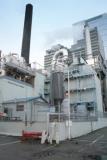|
| State Lines |
Seattle Biomass Developer Threatens to Sue Biomass Opponent (Read full post)
- by Josh Schlossberg
Feb. 15, 2012: An attorney for the Seattle Steam Company
sent a letter to biomass opponent Duff Badgley of Seattle, Wash.
forbidding him from making certain public statements--including use of
the term "incinerator"--in reference to air pollution threats from the
company's existing downtown biomass incinerator and another proposed
natural gas facility.
"The
language you have used publicly is a commercial disparagement of
Seattle Steam's legitimate business and will cause it harm," reads the
letter from Edward W. Pettigrew of Graham and Dunn law firm to Badgley, coordinator for No Biomass Burn and a member of Occupy Seattle.
The letter warns that "having advised you of the falsity of your
statements, your continued use of them will render you liable for
defamation and commercial disparagement."
According to the Merriam-Webster Dictionary,
to "incinerate" is to "cause to burn to ashes." "Incinerator" is
defined as "a furnace or a container for incinerating waste materials."

Seattle Steam Company's biomass incinerator
(Photo: biomassmagazine.com) Is Newspaper Coverage of Biomass Energy Biased? (Read full post)
- by Josh Schlossberg
Two newspapers, the Gainesville Sun in Florida and the Rutland Herald in Vermont, have recently come under fire for giving readers a biased view of the issue of industrial-scale biomass energy.
"What
the Sun readers got was a near black out of the news regarding the
proposed incinerator combined with a few editorials in favor of it,"
said Gainesville resident Karen Orr. "The newspaper's handling of the
bio burner is pretty much the way they handle any local environmental
issue that threatens the status quo, threatens the growth and
development industry, threatens their advertisers, threatens the power
of the local political machine."
On Feb 23, 2012, Winstanley,
developers of a 25-35 megawatt biomass power incinerator proposed for
Springfield, Vermont, held a public information meeting for over two
hundred local residents. During the Question and Answer segment,
Springfield resident Maggie Kelly held up a chart
demonstrating the levels of asthma-inducing particulate matter that
would be emitted from the proposed biomass facility, asking the
developers "Why would the citizens of Springfield allow the construction
of a power plant that is dirtier in many respects than a coal plant?"
"Mt. Tom is actually a pretty good coal-firing plant...so it's not so bad to be compared to Mt. Tom," responded
Winstanley consultant Dale Raczynski. "There's an existing coal plant
out there that has very low emissions. We're being compared to that. And
we have also very low emissions..."
The Rutland-Herald's
article did not quote the developer's admission. Instead, reporter
Susan Smallheer wrote that the developer had denied the chart's data:
"Raczynski said coal was not a source of renewable power, and that the
woodchip plant's emissions per megawatt were lower than the Mount Tom
plant."
Georgia Communities Face Newest Biomass Proposal
A
new citizen group has formed in Jefferson County, Georgia to fight the
construction of a 24 megawatt biomass power incinerator that would burn
wood and tires, proposed by North Star Jefferson Renewable Energy.
Jefferson County Environmental Defense Initiative (JEDI), the newest chapter of Blue Ridge Environmental Defense League (BREDL), is made up of members of Wadley and Louisville, Georgia.
Up to twenty percent of the fuel for the facility would consist of tire scraps, according to JEDI's North Star Jefferson Pollution,
a bi-lingual factsheet. "In addition to natural rubber, modern
automobile tires are made of styrene-butadiene, polybutadiene, carbon
black from petroleum, silica from sand or quartz, zinc oxide, steel,
textile fabric and various chemicals."
|
| Our Health |
Eleven States Sue EPA on Particulate Matter Regulations
- by Josh Schlossberg
Feb. 14, 2012: Eleven states have joined together to sue the U.S. Environmental Protection Agency (EPA) in Federal District Court in Manhattan, NY, for delays in strengthening air quality standards for particulate matter (PM).
The
states, which include California, Connecticut, Delaware, Maryland,
Massachusetts, New Mexico, New York, Oregon, Rhode Island, Vermont, and
Washington, want to force the EPA to comply with its duty to "timely
review and revise as necessary the National Ambient Air Quality
Standards [NAAQS] for particulate matter pollution."
The lawsuit
claims the EPA "has harmed and continues to harm the States by delaying
the adoption and implementation of more protective fine particulate
matter standards that will result in cleaner and healthier air in the
States, benefiting the health and welfare of their citizens."
EPA is required by law to revise air quality standards every five years. The last revision took place in fall of 2006.
"Particulate
matter has scientifically demonstrated negative effects on public
health and welfare," says the states' filing. "The EPA has determined
that particulate matter pollution causes thousands of premature deaths
and tens of thousands of hospital visits in the United States every
year."
Biomass
incinerators generally emit higher levels of particulate matter than
facilities burning coal, the dirtiest of fossil fuels.
|
| Source Watch |
Europe to Burn More U.S. Forests
- by Rachel Smolker
As
if it weren't enough that the U.S. is currently on track towards vastly
increasing combustion of all forms of biomass, now we're also supplying
Europe's even more massive appetite, especially for wood pellets. For
example, Scotland's Forth Energy proposes to burn around 3.5
million tons of pellets, mostly imported, in three large biomass
incinerators. The developers state their intent to obtain all those
pellets largely from the timber industry's "Sustainable Forestry
Initiative" certified logging from North America.
Meanwhile, Drax,
owner/operator of an enormous coal burning facility that provides 7% of
electricity in UK, has announced plans to generate 20% of that power
from co-fired wood pellets. That would be equivalent to about 800
megawatts of biomass electricity--even larger than RWE's Tilbury
station (750 MW). Tilbury is also making the transition to co-fire
around 7 million tons per of imported pellets per year.
European
facilities prefer port locations for easy access to shipping. Both RWE
and Drax are working both sides of the Atlantic to ensure both demand
and supply, investing in new pellet producing plants in the U.S., Canada
and South America. With biomass being sold as "clean, green, carbon
neutral, renewable energy," the market in "climate conscious" Europe is
likely to expand, and we will see far more of our forests pelletized and
shipped overseas before we even have a chance to burn them here!
Study: Logging for "Fire Fuels Reduction" Harms Western Forests
- by Josh Schlossberg
A new University of Wyoming study
challenges timber and biomass industry efforts to log more western
forests on public lands in the name of "forest health." The study, by
Mark A. Williams and William L. Baker and published recently in Global Ecology and Biogeography,
concludes that fuel levels in western dry forests are within historic
ranges and that high-severity wildfire is a regular and natural
occurrence.
"A
set of laws, policies and initiatives that aim to uniformly reduce
fuels and fire severity is likely to move many of these forests outside
their historical range of variability with adverse effects on biological
diversity," says the study. The findings contest timber and biomass
industry claims that past fire suppression has caused forests to become
"unhealthy," with more logging the best cure.
|
| Please Donate to the National Anti-Biomass Campaign |
The Anti-Biomass Incineration Campaign
works on the national, regional, and community levels to oppose
industrial biomass energy incineration by influencing legislative
policy, through public and media education and outreach, and by
providing networking, resources and organizing support to communities
across the U.S.
CLICK HERE to make a safe and secure, tax deductible online donation to the Campaign through PayPal or Just Give. |
|
| From the Editor |
- by Rachel Smolker, Managing Editor The blatant absurdity of biomass energy is laid out in this month's lineup of articles for The Biomass Monitor.
As
industry expands massive new plans to export wood pellets across the
Atlantic Ocean to Europe to burn as supposedly "clean, green, carbon
neutral" energy, a biomass opponent is threatened with a lawsuit for
referring to the Seattle Steam biomass facility as an "incinerator."
Meanwhile, eleven states join together to sue the U.S. Environmental Protection Agency (EPA)
over failure to enact particulate regulations, even as many of those
same states, including my own Vermont, are supporting the construction
of more biomass incinerators.
While Congress is working to
undermine any and all EPA regulation, EPA itself has failed to act upon a
mandate to regulate air pollution emissions from biomass boilers.
Little rhyme or reason and hard to choose between laughter and tears! |
 |
|
|
| Biomass Buster of the Month |
Karen Orr - Florida 
Karen Orr was among the first Gainesville residents to oppose a 100 megawatt biomass incinerator proposal by American Renewables.
While her legal appeal of the air permit and a strong, bi-partisan
grassroots campaign--in which Karen played a major role educating the
public and decision makers--weren-t able to stop the facility from being
built, they have mandated better air pollution monitoring, oversight,
and transparency. The forthcoming information will prove invaluable to
biomass opponents elsewhere.
If
more incinerators like the one in Gainesville are built across the
U.S., Karen predicts that "we'll plunge further into debt, destroy
irreplaceable natural resources and send another portion of the
biosphere up in smoke."
|
 |
|
|
| Eye on D.C. |
EPA Drags Feet on Boiler Rule
- by Rachel Smolker
The U.S. Environmental Protection Agency (EPA)
was mandated twelve years ago to regulate emissions of toxins from
commercial and industrial boilers (including biomass and waste
incinerators) but, unbelievably, has still failed to do so. In 2011, EPA
finally published standards for "MACT" (maximum available control
technology, to control toxins such as mercury, dioxin and particulates)
for industrial boilers. But, under pressure from industry and a Congress
intent on undermining virtually all environmental protections, arguing
they "kill jobs," the EPA backtracked with reconsideration and an
administrative stay on implementation of the rules.
The Sierra Club challenged EPA. Now the D.C. Court of Appeals
has ruled that the delay was "arbitrary" and unlawful. The game isn't
over yet: Congress is now considering legislation that would "relieve"
industry from the "burden" of EPA regulation.
|
 |
|
|
| Take Action! |
Want to help get the word out about impacts from biomass incineration? Become an e-distributor of THE BIOMASS MONITOR!

THE BIOMASS MONITOR
is the only monthly national newsletter in the U.S. covering the
impacts to public health, climate, forests, and communities from burning
forests for electricity?aka biomass power incineration?and offering
clean energy alternatives.
Email us at thebiomassmonitor [at] gmail.com for details. |
 |
|
|
| Beyond Burning |
Muscle Power
- by Eliza Barclay Treehugger.com 
We've covered gyms that harvest power from human exertion in Hong Kong, where California Fitness has
installed cardio machines that help light the facility. Now, a gym in
Portland, Oregon is taking the green gym philosophy one step further by
incorporating an environmental ethic into the whole business plan. The Green Microgym generates as much as 40 percent of its own electricity from solar panels and exercise machines like stationary bikes.
Gym owner Adam Boesel recently demonstrated for the Los Angeles Times
the Human Dynamo, an exercise machine consisting of four spin bikes
attached to a small generator. While pedaling one of the bikes and
turning an arm crank that strengthens the upper body, a digital readout
showed the amount of watts Boesel's bike produced. The Human Dynamo
system can produce 200 watts to 600 watts of energy an hour, depending
on whether all four bikes are in use.
|
 |
|
|
|



